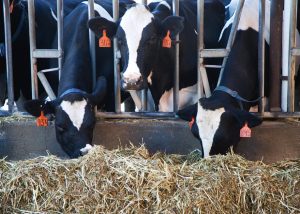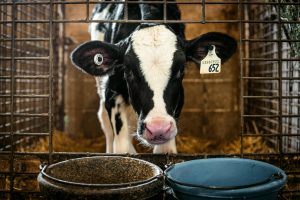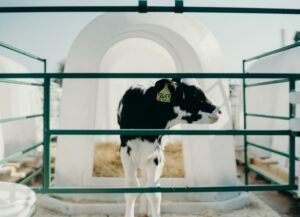Mohsen Sahraei Belverdy, Ali A. Alamouti, and Mohammad Hossein Azizi
Introduction
Numerous methodologies have been designed to increase the amount of a nutrient that passes through the rumen without degradation by the rumen microorganisms, thereby resulting in the delivery of a larger portion of that nutrient to the lower gastrointestinal tract. Some of these methods include heat and chemical treatment and polymeric compounds of amino acids4.
The microencapsulation technique has widespread application in the agricultural, food, and pharmaceutical industries3. This technique is also applicable to the ruminant feed industry, as it protects nutrients from degradation in the rumen, making it possible to increase the bioavailability of the core ingredient in the small intestine. Microencapsulation is defined as a process in which particles of solids or droplets of liquids or gases at micron sizes are surrounded by a coating material or embedded in a homogeneous or heterogeneous matrix to create small capsules with many useful properties12.
The product obtained from this process is called microencapsulate, and it includes both microspheres and microcapsules. Microcapsules are particles consisting of an inner core containing the active substance, which is covered with a polymer layer constituting the capsule membrane. Microspheres are matrix systems in which the core is uniformly dispersed and/or dissolved in a polymer network. Microspheres may be homogeneous or heterogeneous depending, respectively, on whether the core is in the molecular state (dissolved) or in the form of particles (suspended)9.
This review will briefly discuss some aspects of microencapsulation, such as the wall material, core ingredients, encapsulation techniques, and some of their uses in ruminants’ feed technology.
Coating materials
Originally, most methods related to encapsulation dealt with the protection of hydrophilic compounds such as choline, amino acids, proteins, vitamins, enzymes, carbohydrates, drugs, and hormones. Various material including proteins, polysaccharides, lipids, and synthetic polymers can be used for the encapsulation of ingredients in the food industry3. However, as the enzymatic activity of ruminal microorganisms vigorously destroys many of these coating agents, only a limited number of these techniques has been applied to the ruminants’ feed industry. Materials to be chosen as a coating matrix should have these specific properties to protect the core nutrient/feed from ruminal degradation:
- Be insoluble in the rumen of the animal where the pH is greater than 6.
- Be soluble in the more acidic juice (pH 1.5 – 2) of the abomasum.
- Be resistant to microbial attack.
- Possess mechanical properties to withstand breakage (e.g. flexibility and strength).
The encapsulated product should also contain a high amount of the core/active ingredient, have a smooth surface and appropriate specific gravity (1.2 – 1.7 g/cm3)11. The capsules must be sufficiently dense to ensure that they do not remain floating at the top layer of the rumen contents for an unlimited time. The capsule density can be conveniently adjusted by varying the ingredients forming the core of the capsule, e.g. through the addition of a high-density weighing agent such as kaolin, chromium sesquioxide, or barium sulfate10.
Recently, encapsulation with lipid materials has gained much attention. Lipid-protected products rely on their resistance to enzymatic attack, which maintains the integrity of the protective coat in the rumen, while it is digested by intestinal enzymes where the active core components are released. In designing a fat-coated product, an active ingredient is either embedded in a lipid matrix or prepared in small spheres, then coated with lipid material. In general, coating fats consist of fatty acids with a melting point of ≥40 ºC and having at least 14 carbon atoms.
Lipid coating for bypassing the nutrients of interest to the ruminant intestine has the advantage of using relatively low-cost food-grade materials compared to formulated polymeric coatings5. In addition, fats and fatty acids are used almost globally in dairy rations, which further justifies the idea of using the same ingredient as a coating material. Contrastingly, the disadvantages of this protection method include low payloads of the active material and its limited post-ruminal release and absorption. The latter is generally inversely related to the degree of rumen protection2. Nevertheless, several lipid-based, rumen-protected products are commercially available. For instance, lipid encapsulation technology has been used to produce rumen-protected conjugated linoleic acid6.
Currently, a new method has been introduced that protects polyunsaturated fatty acid oils from ruminal degradation using a polymeric coating2. In this method, the active ingredient is coated with multiple layers including an inner coating such as zein or caseinate and an outer layer consisting of a delayed-release material such as gum arabic, gelatin, ethylcellulose, or hydroxypropyl methylcellulose.
Microencapsulation techniques
Some of the major encapsulation techniques using fats are fluidized bed coating, spray cooling/chilling, and centrifugal suspension separation.
Fluidized bed coating
This type of coating leads to forming of capsules called a reservoir structure, where the particles are coated by a layer. Using this technique, the lipid material is sprayed at temperatures above its melting points onto a template to constitute the shell. As it is cooled, the fat mass solidifies around the template and forms a protective coat. Fluidized bed is applied to various products for encapsulation; some of which include vitamins B and C and minerals such as potassium chloride1, 13.
Spray cooling/chilling
Spray cooling and spray chilling are two commercially available encapsulation processes that both involve dispersing the core material within a melted lipid through homogenization process. Here, the mixture of core and lipid wall is atomized in the low-temperature air causing the fat to solidify around the core, thereby forming a crude encapsulated product7. These techniques have been used for encapsulation of water-soluble core materials such as minerals, water-soluble vitamins, enzymes, and some flavors7.
Centrifugal suspension
Centrifugal suspension separation is extensively used for coating of particles with a thin shell of fat or wax. In this technique, the particles are suspended in a melted shell material and poured onto a spinning disk. As the particles spread on the disk, a thin film of shell material is applied. When they move toward the edge of the rotating disk through centrifugal force, the particles leave apart from the fat film and microcapsules of core-shell are formed13.
Application
Various techniques are now available to protect single nutrients from ruminal degradation, some of which were briefly discussed above. As modern dairy cows continue to reach higher milk production records, the application of these technologies seems to extend to many other feed additives to precisely meet cows’ nutrient requirements.
About the authors
Mohsen Sahraei Belverdy received a PhD degree in Ruminant Nutrition from the Department of Animal and Poultry Science, College of Aburaihan, University of Tehran, Tehran, Iran in 2019. His main area of interest is improving the nutritional value of feeds for ruminants. His doctoral thesis was about the encapsulation of soybean meal with fats and its use in high-yielding dairy cows’ rations. He has published two manuscripts related to his thesis in international and national journals. m.sahraei@ut.ac.ir
Ali Assadi-Alamouti has been serving as University Assistant Professor in the Department of Animal and Poultry Science at the University of Tehran, Tehran, Iran since 2010. His area of work is ruminant nutrition and he is working on several projects in this area. He has presented papers at conferences and has published articles and papers in various journals. At this time, he is participating in a project related to the encapsulation of feed to use in ruminant nutrition.
Mohammad Hossein Azizi is a Professor in the Department of Food Science & Technology at the University of Tarbiat Modarres, Tehran, Iran. He received his PhD in Food Science & Technology from Central Food Technological Research Institute (CFTRI), Mysore, in 2000. His research interests are in the areas of cereal science and packaging technology. At the present time, his research efforts are focused on using edible films as coating agents for food applications.
References
- DeZarn, T.J. 1995. Food ingredient encapsulation. In Encapsulation and Controlled Release of Food Ingredients; Risch, S. J. and G. A. Reineccius. ACS Symposium Series.Washington, DC.
- Gadeyne, F., De Neve, N., Vlaeminck, B. and Fievez, V. 2017. State of the art in rumen lipid protection technologies and emerging interfacial protein cross‐linking methods. European Journal of Lipid Science and Technology. 119:1600345.
- Gaonkar, A.G., Vasisht, N., Khare. A.R. and Sobel. R. 2014. Microencapsulation in the food industry: a practical implementation guide. Elsevier.
- Gately, S.F., Wright, D.R. and Valagene. R.J. 2009. Granular feed supplement. US patent. 0092704 A1.
- Jenkins, T.C. and Bridges, W.C. 2007. Protection of fatty acids against ruminal biohydrogenation in cattle. European Journal of Lipid Science and Technology. 109: 778–789.
- Perfield, J.W., Lock, A.L., Pfeiffer, A.M. and Bauman, D.E. 2004. Effects of amide-protected and lipid-encapsulated conjugated linoleic acid (CLA) supplements on milk fat synthesis. Journal of Dairy Science. 87: 3010–3016.
- Rahman, S.M. 2007. Handbook of Food Preservation. second ed. CRC Press, Boca Raton.
- Schwab, C.G. and Ordway, R.S. 2003. Methionine supplementation options. In Proc. Four-State Applied Nutrition and Management , July (pp. 9-10).
- Shahidi, F. and Han, X.Q. 1993. Encapsulation of food ingredients. Critical Reviews in Food Science and Nutrition 33: 501–547.
- Sibbald, I.R., Place, C., Loughheed, T.C., Drive, G.W. and Linton. J.H. 1970. Encapsulated biological materials for feeding to ruminants and process for the production thereof. US patent. 3, 541, 204.
- Sýkora, T., Rabišková, M., Třináctý, J., Vetchý, D., Häring, A. and Dvořák, P. 2007. Postruminal delivery system for amino acids and proteins in cattle. Acta Veterinaria Brno. 76: 547-552.
- Thies, C. 1996. A survey of microencapsulation processes. In: Benita, S. (Ed.), Microencapsulation: Methods and Industrial Applications. Marcel Dekker, New York, NY, pp. 1-19.
- Toublan F.J.J. 2014. Fats and waxes in microencapsulation of food ingredients. In: Gaonkar A.G., Vasisht N., Khare, A.R., Sobel, R. (Ed). Microencapsulation in the food industry. San Diego (CA): Elsevier; pp. 253-265.









